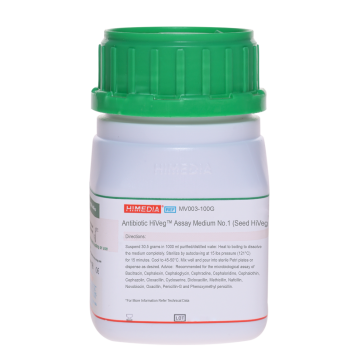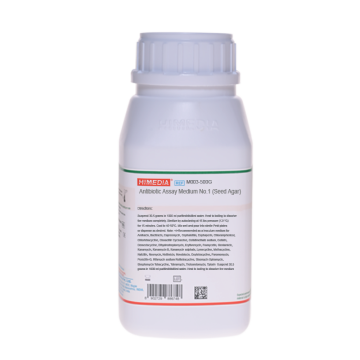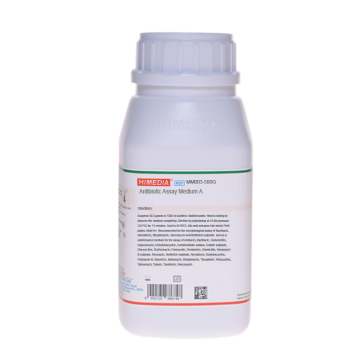 Your enquiry has been submitted
Your enquiry has been submitted
Antibiotic Assay Medium A
Intended use
Antibiotic Assay Medium A is used for microbiological diffusion assay of several antibiotics as per British Pharmacopoeia.
Composition**
| Ingredients | Gms / Litre |
|---|---|
| Peptone | 6.000 |
| Tryptone$ | 4.000 |
| Yeast extract | 3.000 |
| HM Peptone B# | 1.500 |
| Glucose monohydrate | 1.000 |
| Agar | 15.000 |
pH after sterilization (at 25°C): 6.6±0.1
**Formula adjusted, standardized to suit performance parameters
$- Equivalent to Pancreatic digest of casein
#- Equivalent to Beef extract
Directions
Suspend 30.45 grams (the equivalent weight of dehydrated media) in 1000 ml R-water/purified / distilled water. Heat to boiling to dissolve the medium completely. Sterilize by autoclaving at 15 lbs pressure (121°C) for 15 minutes.Cool to 45-50°C. Mix well and pour into sterile Petri plates.
Adjust the pH of the medium, using freshly prepared buffer solution as recommended by the British Pharmacopoeia for the antibiotic assayed.
Advice :Recommended for the microbiological assay of Josamycin, Josamycin propionate, Bacitracin zinc
Principle And Interpretation
This medium is also used as inoculum and maintenance medium for different test organisms for antibiotic assays. Composition of this medium is in accordance with British Pharmacopoeia(1).
Essential nutrients, vitamins, mineral, trace elements and growth factors are supplied by peptone, tryptone, yeast and HM peptone B. Glucose monohydrate in the medium serves as the carbon source for stimulating the growth of the test microorganism. Agar provides excellent medium for antibiotic diffusion and gives well defined zones of inhibition. Freshly prepared plates should be preferably used for assaying antibiotics. Test organisms is inoculated in sterile seed agar pre-cooled to 40-45°C and spread evenly over the surface of solidified base agar. All conditions in the microbiological assay must be controlled carefully. One of the critical and important step for obtaining good results is use of appropriate standard culture media.
Type of specimen
Pharmaceutical preparations
Specimen Collection and Handling
For pharmaceutical samples follow appropriate techniques for handling specimens as per established guidelines (1).
After use, contaminated materials must be sterilized by autoclaving before discarding.
Warning and Precautions :
Read the label before opening the container. Wear protective gloves/protective clothing/eye protection/ face protection. Follow good microbiological lab practices while handling specimens and culture. Standard precautions as per established guidelines should be followed while handling specimens. Saftey guidelines may be referred in individual safety data sheets
Limitations :
- Freshly prepared plates must be used or it may result in erroneous results.
Performance and Evaluation
Performance of the medium is expected when used as per the direction on the label within the expiry period when stored at recommended temperature.
Quality Control
Appearance: Cream to yellow homogeneous free flowing powder
Gelling: Firm, comparable with 1.5% Agar gel
Colour and Clarity of prepared medium: Yellow coloured slightly opalescent gel forms in Petri plates.
pH: 6.50-6.70
Growth Promotion Test
As per British Pharmacopoeia
Cultural Response
Cultural characteristics observed after an incubation at specified temperature for 18-24 hours.
| Organism | Inoculum (CFU) | Growth | Recovery | Antibiotics assayed | Incubation Temperature |
|---|---|---|---|---|---|
| Bacillus subtilis subsp. spizizenii ATCC 6633 (00003*) | 50-100 | good-luxuriant | >=70% | Josamycin, Josamycin propionate | 35-37°C |
| Micrococcus luteus ATCC 10240 | 50-100 | good-luxuriant | >=70% | Bacitracin zinc (Adjust the pH to 7.0 ± 0.1) | 35-39°C |
| Micrococcus luteus ATCC 9341 | 50-100 | luxuriant | >=70% | Rifamycin sulphate | 35-39°C |
*- Corresponding WDCM numbers
Storage and Shelf Life
Store between 10-30°C in a tightly closed container and use freshly prepared medium. Use before expiry date on the label. On opening, product should be properly stored dry, after tightly capping the bottle inorder to prevent lump formation due to the hygroscopic nature of the product. Improper storage of the product may lead to lump formation. Store in dry ventilated area protected from extremes of temperature and sources of ignition Seal the container tightly after use. Use before expiry date on the label.
Product performance is best if used within stated expiry period.
Disposal
User must ensure safe disposal by autoclaving and/or incineration of used or unusable preparations of this product. Follow established laboratory procedures in disposing of infectious materials and material that comes into contact with sample must be decontaminated and disposed of in accordance with current laboratory techniques (2,3).
Reference
- British Pharmacopoeia, 2020, The Stationery office British Pharmacopoeia
- Isenberg, H.D. Clinical Microbiology Procedures Handbook. 2nd Edition.
- Jorgensen, J.H, Pfaller, M.A., Carroll, K.C., Funke, G., Landry, M.L., Richter, S.S and Warnock., D.W. (2015) Manual of Clinical Microbiology, 11th Edition. Vol. 1.
| Product Name | Antibiotic Assay Medium A |
|---|---|
| SKU | M003B |
| Application/ Industry | Pharmaceutical |
| Product Type | Regular |
| Physical Form | Powder |
| Regulatory | BP |
| Origin | Animal |
| Packaging type | HDPE |
| References | 1. Pelczar M. J. Jr., Reid R. D., Chan E. C. S., 1977, Microbiology, 4th Edi, Tata McGraw-Hill Publishing Company Ltd,New Delhi 2.The United States Pharmacopoeia, 2018, The United States Pharmacopoeial Convention,Rockville, MD. 3.Murray P. R., Baron J. H., Pfaller M. A., Jorgensen J. H. and Yolken R. H., (Eds.), 2003, Manual of Clinical Microbiology,8th Ed., American Society for Microbiology, Washington, D.C. 4.Grove and Randall, 1955, Assay Methods of Antibiotics Medical Encyclopedia, Inc.New York. 5.European Pharmacopoeia, 2017, European Department, for the Quality of Medicines6.British Pharmacopoeia, 2016,The Stationery office British Pharmacopoeia 8.Isenberg, H.D. Clinical Microbiology Procedures Handbook. 2nd Edition. 9.Jorgensen,J.H., Pfaller , M.A., Carroll, K.C., Funke, G., Landry, M.L., Richter, S.S and Warnock., D.W. (2015)Manual of Clinical Microbiology, 11th Edition. Vol. 1. |
| Customized Product Available | No |







